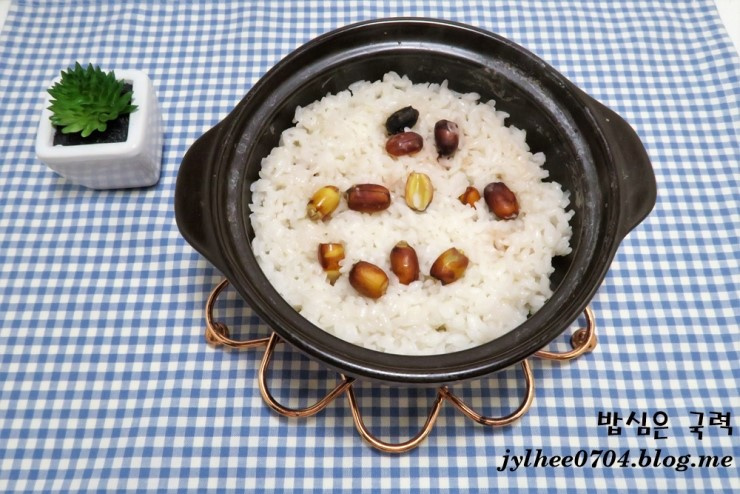Delicious Lotus Seed Rice (Yeonjayukbap) – A Nutritious Delight
Aromatic Lotus Seed Rice Recipe for a Healthy and Flavorful Meal

Hello everyone! A hearty meal starts with a nourishing table, and today we’re crafting a wonderfully nutritious Yeonjayukbap (Lotus Seed Rice) using a special ingredient: yeonjayuk, or lotus seeds! These small seeds are packed with protein, minerals, and powerful antioxidants. Traditionally, in Korean herbal medicine texts like Donguibogam, lotus seeds are known to strengthen the heart, alleviate insomnia, tonify the five internal organs, and treat thirst and diarrhea. The abundant antioxidants in lotus seeds are excellent for combating free radicals that cause cellular aging and damage, thus aiding in preventing blood vessel aging. Furthermore, their ability to inhibit fat absorption makes them a popular choice for those on a diet. Historically, lotus seeds were even used as medicinal ingredients for royalty. Their taste is subtly nutty and pleasant, reminiscent of roasted chestnuts or peanuts, making them enjoyable for everyone. It’s recommended to consume about 25-30 lotus seeds daily; consuming too many might lead to side effects like constipation or delayed urination, so moderation is key. These valuable lotus seeds can be enjoyed in various ways, including Yeonjayukbap, salads, or tea. Today, we’ll focus on the easiest and most delicious way to enjoy them: Yeonjayukbap! We’ll be using a ttukbaegi (earthenware pot) instead of a rice cooker to achieve a wonderfully chewy texture and rich flavor. Let’s get cooking!
Ingredients (Serves 1)- 15-20 lotus seeds (yeonjayuk), adjust to preference
- 1 cup short-grain rice (approx. 180ml)
- 1 1/4 cups water (approx. 225ml)
- Pinch of roasted salt (or a tiny amount of regular salt)
Cooking Instructions
Step 1
First, let’s prepare the lotus seeds. Place the lotus seeds in a bowl and gently rinse them once or twice under running water. Avoid washing too vigorously, as this can strip away nutrients. A gentle rinse is all you need.

Step 2
The lotus seeds have a small, tough tip. Using kitchen shears or sturdy scissors, carefully snip off this tip from each seed. This step makes the seeds more pleasant to eat in the rice. Trim the tips off all the lotus seeds.

Step 3
This step involves removing the outer skin of the lotus seeds, which is optional but recommended for a smoother texture. We’ve prepared 20 trimmed lotus seeds here. (The lotus seeds in the photo have had their skins removed after being used for tea.) If you’re making the rice directly, you can skip this step and proceed to the next. It’s easier to remove the skins after boiling the lotus seeds for tea.

Step 4
This is the process for making lotus seed tea. Place 20 trimmed lotus seeds into a pot with 2 liters of fresh water. Bring it to a boil over high heat, then reduce the heat to medium-low. Cover and simmer gently for 30 minutes to 1 hour. This will yield a flavorful lotus seed tea. Set aside the boiled lotus seeds for use in the rice.

Step 5
After brewing the tea, carefully peel the softened skins off the lotus seeds. If you are using dried lotus seeds directly for the rice, you must soak them in water for at least 12 hours before this step. For cooking the rice, you can use unsoaked lotus seeds or those whose skins have been removed after making tea.

Step 6
Now, let’s prepare the rice for cooking. Rinse 1 cup of short-grain rice (for one serving) thoroughly. Soaking the rinsed rice in water for about 30 minutes will result in fluffier and tastier cooked rice. If you’re short on time, you can skip the soaking step.

Step 7
Prepare a pinch of roasted salt to enhance the flavor of the rice. If you don’t have roasted salt, a very small amount of regular salt will work. Be careful not to add too much, as it can make the rice too salty. Just a tiny pinch is needed to subtly enhance the taste.

Step 8
In your ttukbaegi (earthenware pot), add the soaked rice and the prepared 15-20 lotus seeds. Pour in the measured 1 1/4 cups of water. Finally, add the pinch of roasted salt. Even with the salt added, the small amount ensures the rice won’t taste salty; instead, it subtly brings out the rice’s natural flavor.

Step 9
Cooking the rice: Heat control is key for ttukbaegi rice. Start by bringing the water to a boil over high heat. Once it starts boiling, reduce the heat to medium and cook for about 10 minutes. Then, lower the heat to very low and let it simmer for another 5 minutes. Finally, turn off the heat and let the rice steam for 10 minutes. This process will result in a beautifully glossy and delicious Yeonjayukbap with perfectly cooked grains. Ttukbaegi rice offers a wonderful texture where each grain stands out!




